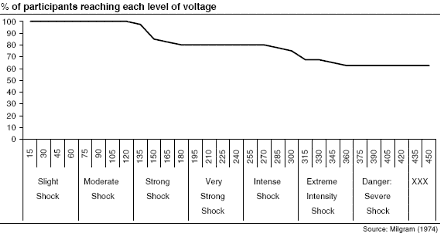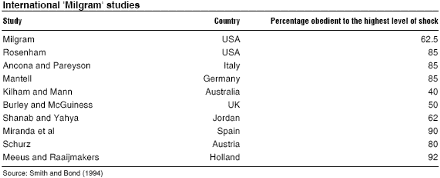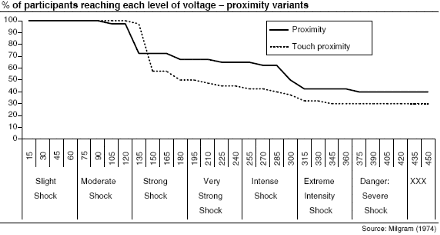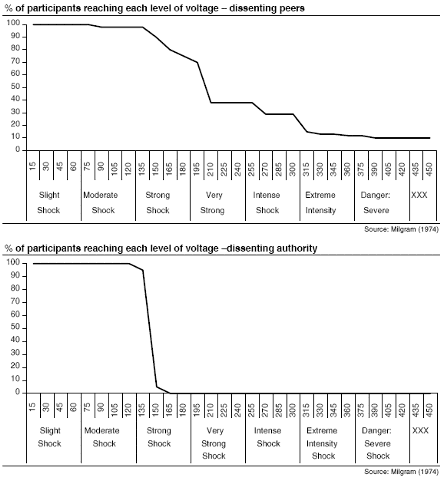The second classic experiment from social psychology that is relevant here is Stanley Milgram’s [7] work. Intriguingly, Milgram was a classmate of Zimbardo. Milgram’s work was triggered in the wake of World War II. He wanted to investigate why it was that so many ordinary people either simply said nothing about their leaders clearly abhorrent policies, or even worse chose to follow their example.
Milgram devised a simple but stunningly effective experiment. Subjects were asked to help in an experiment. They were told they would be administering electric shocks to a ‘learner’ at the instruction of a ‘teacher’. The subjects were told that they were involved in a study on punishment effects on learning and memory. The subjects sat in front of a box with electric switches on it. The switches displayed the level of volts that was being delivered, and a text description of the level of pain ranging from ‘slight’ through to ‘very strong’ and up to ‘danger severe’, culminating in ‘XXX’. When the buttons were depressed, a buzzing sound could be heard. The ‘teacher’ was a confederate of the experimenters, and wore a white coat and carried a clipboard.
They would instruct the subjects when to press the button. In the classic variant of the experiment, the subject couldn’t see the person they were shocking, but they could hear them. At 75 volts, the ‘learner’ grunts, at 120 volts he starts to complain verbally, at 150 volts he demands to be released, at 285 volts the ‘learner’ makes a response that Milgram said could only be described as ‘an agonized scream’. Before conducting the experiment, Milgram’s prior belief was that very few people would administer high levels of shock. Indeed forty psychiatrists canvassed by Milgram thought that less than 1% would give the full 450-volt shock. After all, they reasoned, Americans just didn’t engage in such behaviour.(Sounds like a classic case of the fundamental attribution error doesn’t it!)
The chart below shows the percentage of respondents who progressed to each level of voltage. 100% of ordinary Americans were willing to send up to 135 volts (at which point the ‘learner’ is asking to be released) through someone they didn’t know. 80% were willing to go up to 285 volts (at which point they are hearing agonising screams). Over 62% were willing to administer the full 450 volts, despite the screams and the labels on the machine stating ‘severe danger’ and ‘XXX’!

Nor are Milgrams results unique. The table below shows the average compliance level to the maximum voltage from a number of studies. Incidentally, university ethics boards outlawed Milgram style experiments in the late 1980s, so no more modern studies are available, although we have little reason to believe they would show anything different from the majority of findings below.

Milgram tested many variations of his experiment. However few seemed to have major impacts upon the level of obedience to authority. For instance, the chart below shows the effects of enabling the subject to now see (as well as hear) the ‘learner’, and when the subject had to force the ‘learners’ hand onto a metal plate to administer the shock. In the former condition still 40% of subjects went to 450 volts. In the latter, 30% still went to the maximum level of shock!

Once again these were ordinary people, people like you and I, yet simply because a figure in authority instructs them to do so they become willing to make another person suffer. Another clear win for the situational perspective. The Milgram experiment has some very clear implications for finance. Firstly, given people’s tendency to obey, a culture of corporate integrity must come from the very top down. Simply stated, if the head of an organisation orders an employee to do something, the evidence here suggests they will generally comply.
From a situational viewpoint the man at the top may not be intrinsically bad, but if put in the ‘correct’ environment may turnout that way. I have regularly berated the use of stock options to pay management. In our view, it tends to cause the holders of such options to be extremely myopic and take on excessive risk since they enjoy an asymmetric payoff due to the nature of zero downside inherent within options. However, once such devices are in place, the situational prediction is that management will behave in a manner consistent with the incentive.
Often, share options are enough to turn otherwise good people bad. Another application of Milgram’s results is that we should train analysts to be critical of company management. The more god-like the management, the easier it will be for them to influence analysts who cover the stock. CEOs are generally successful people. They have made it. As such we tend to interpret their success as the result of their disposition (the fundamental attribution error). We are in awe of such individuals. Few, if any, analysts were willing to ask questions of Bernie Ebbers at the height of the TMT boom, when he and his ilk were regarded as the new masters of the universe[8]. Dissent is key.
We must learn to question those in authority. In the past, my managers have often reminded me that investment banking is not a democracy. Indeed it is not, but if we lose the will to dissent the results can be disastrous (at least that is my defence for being a cantankerous pain to manage!). The only thing Milgram found that consistently resulted in rapid drop offs in compliance within his experiment was dissent. For instance, Milgram ran one variant of his experiment with one psychologist and three helpers (two of whom were confederates of the experimenters, and one genuine subject). One of the helpers asks the question, another says whether the answer is correct, the third (the real subject) throws the switch to administer the shock. At 150 volts one of the helpers (one of the confederates) walks out of the experiment. At 210 volts, the other helper (confederate) also walks out. The psychologist goes on alone with the true subject.
The chart below shows the percentage of compliance at various voltages. Once the first helper leaves the number of compliant subjects drops from 90% to around 35%. Following the second helper walking out, the compliance rate drops steadily, although 10% still go on to administer the maximum voltage. The single best method of generating dissent amongst the subjects was to have conflicting authorities. In this version two psychologists were present and one subject. At 150 volts, one of the psychologists began a prepared argument with the other over whether the experiment should be stopped. As the chart below shows, this argument resulted in the complete cessation of shocking.

Morck[9] has used the Milgram experiments to argue that truly independent directors are our best hope of good governance. Too many boards are populated by cronies of the management. The Higgs report finds that almost half of the so-called independent directors on UK boards are recruited by the CEO through personal contacts or friendships! Morck argues that dissenting boards may help “induce greater rationality and more considered ethics in corporate governance”. New support for good governance comes from a recent study by Bebchuk et al[10].
They construct an entrenchment index, which attempts to measure the limits of shareholders to impose their will onto management. There are six inputs into their score – whether the company has a staggered board, whether it has limits to shareholders’ amendments of the bylaws, whether a supermajority is required for merger and charter amendments, whether poison pill and golden parachutes are used. Firms are ranked on the basis of the number of these provisions they have with 0 being a low entrenchment firm, and 6 being firms with very high levels of entrenchment. Bebchuk et al find that an equal weighted long short portfolio which is long those stocks with a 0 score and short those stocks with a 6 score generates a 7.2% annual compound abnormal return (after correcting for market, size, style and momentum) in the sample 1990-2003.
They also find that the return rises to 9.6% when value weighted portfolios are used! So good governance pays, but it is much more than just a box ticking exercise. Indeed just as this note was going to press, an email interview with Thomas Donaldson, a legal studies professor from Wharton, arrived in my inbox. The interview contained the following passage: “We have followed a mythology that if you write an elaborate code of ethics, appoint people to distribute it, and get everybody to sign off on a fat rule book every year, this will somehow prevent major disasters. We have abundant evidence now that it simply doesn’t work this way.”
6 This title is stolen from Thomas Blass’ excellent biography of Stanley Milgram
7 Milgram (1974) Obedience to authority
8 Intriguingly, Malmendier and Tate (2004) Superstar CEOs show that award winning CEOs extract more compensation from their companies following awards. They spend more time writing books and lecturing and gaining board seats. Most importantly, firms with Superstar CEOs have stocks that underperform the market on a one, three and five year horizon!
9 Morck (2004) Behavioral finance in corporate governance – independent directors and non-executive chairs, HIER Working papers 2037
10 Bebchuk, Cohen and Ferrell (2004) What matters in corporate governance, DP 491, available from www.ssrn.com
By Dr James Montier
Next: The conditions that turn good people bad
Summary: Index